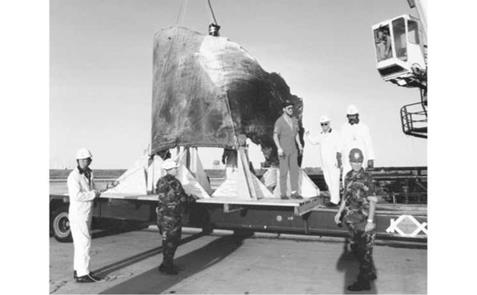FURTHER INVESTIGATIONS
The Air India experience caused Newport to ponder further the difficult question of locating and salvaging the lost Mercury spacecraft. As he researched where it might be on the ocean floor, he realized that no existing ROV was capable of reaching an object three miles down. After returning from Ireland he asked the Smithsonian’s National Air and Space Museum (NASM) about Liberty Bell 7 “but got nowhere.” His next major salvage assignment involved the tragic loss of NASA’s space shuttle Challenger and her crew of seven on 28 January 1986. Newport spent two months working out of Port Canaveral, Florida on the contract salvage ship Stena Workhorse. The major discovery of the operation occurred while Newport was on a midnight shift piloting the Gemini ROV and brought a booster section to the surface. It happened to be the most crucial find of the search – the segment of the right-hand solid rocket booster where the burn-through of an O-ring had set in motion the fatal explosion and NASA’s greatest tragedy to that time.
|
A 4,000-pound segment of Challenger’s nght-hand solid rocket booster is offloaded at Port Canaveral from the Stena Workhorse following its recovery on 13 April 1986. (Photo: NASA-JSC) |
“The operation was a real grind,” he says, “mostly due to the numerous technical problems we had with the Gemini ROV. During six weeks we repaired its electrical umbilical a staggering 32 times and even replaced the whole thing four times: not a good record. But while I was in Florida and on one of my rare days off, I visited the archives at the Kennedy Space Center and collected a little more data on Liberty Bell 7.”6 He also began to establish solid contacts in his ongoing research into the loss of Grissom’s spacecraft, including the Gemini and Apollo astronaut Tom Stafford, who would not only prove to be a staunch advocate of Newport’s plans but also provided important leads and privileged access to documents and information to assist him in his quest to pinpoint the location of the sunken craft. “Gene Cernan, John Yardley (McDonnell Aircraft Corporation) and Robert F. Thompson (JSC) were also a big help.”7
Another interested and influential ally was Max Ary, then President of the Kansas Cosmosphere and Space Center in Hutchinson, Kansas, who had also considered the possibility of finding and recovering Liberty Bell 7. As he told Lawrence McGlynn for collectSPACE, “Actually my interest, relative to the Cosmosphere, in recovering the Liberty Bell 7 goes way back. In 1978, before the Cosmosphere opened but when we were still trying to put together a space artifact collection, one of my many basic goals was to place on exhibit examples of all three of the early manned spacecraft. We knew when we were going to get the Gemini and Apollo, but we knew, because of the rarity of the Mercury [capsules] that it was going to be our biggest challenge. When I realized that all of the available Mercury [craft] were on long-term exhibit, it occurred to me there was still one that might be made available, and that was LB7.
Being from Kansas, and with no knowledge of the ocean, I didn’t specifically see why there would be any problem in recovering something from 16,000 feet down. As they often say ‘ignorance is bliss.’”8











